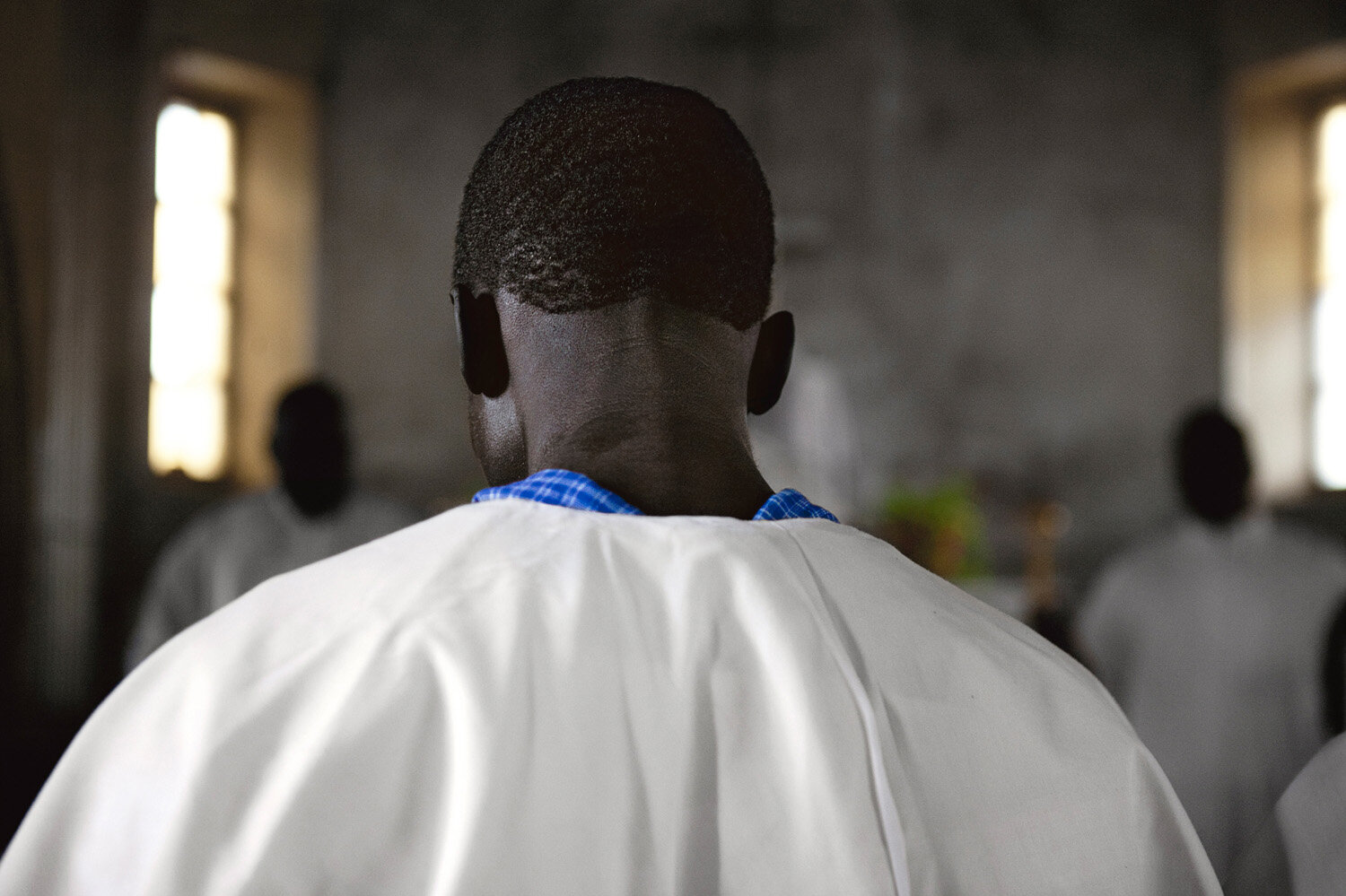Becoming South Sudan
Tate Modern curator Emma Lewis on artist Alinka Echeverría’s acclaimed series of photographs, Becoming South Sudan.
Text by Emma Lewis
Alinka Echeverría
Rebel, 2011
On July 9, 2011, South Sudan was made an independent sovereign state, an act of emancipation from the Republic of Sudan that effectively ended around forty years of violent civil confrontations. As the creation of two separate nations brought the challenges of establishing national identity, so too came a myriad of problems to do with changing identity at the level of the individual. For South Sudan, this meant people from some sixty-three different tribes now being defined as one nation, with demilitarised soldiers being assigned institutional roles as police officers or prison guards. It meant a country that war has left disproportionately populated by women seeking how to establish a society in which they are able to exercise new rights. And it meant a place in which 70% of the population is under thirty years old determining how to forge roles for its young people into this new nation.
What Alinka Echeverría photographed during that period was therefore not the emergence of a fully functioning and unified society, but a place in which latent fragmentation and poor infrastructure meant a country and its civilians—many of whom are returning exiles—in a state of flux. As the series title Becoming South Sudan denotes, she documented a country as it began a long and very gradual process of coming into being. Her interest at this time was primarily in how this formation of a new identity manifests itself. This included outward signs such as religious dress and government-issue uniforms, the rituals, and displays that project an image of national solidarity at a time of great change, and the moments that encapsulate the difficult reality of such upheaval. The works are presented in three formats: scenes such as military rehearsals and refugees in transit; large-format, close-up portraits that emphasize the singularity of the subject; and seventeen full-length, life-size singular portraits of the country’s first graduating senior police officers. All depict people in the attire and spaces that illustrate their role or position at that defining moment in the birth of their nation.
Alinka Echeverría
Altar, 2011
Alinka Echeverría
Sunday, 2011
The portrayal of ‘types’ as seen in the singular portraits has a long and established history in photography. August Sander, Irving Penn, and Richard Avedon produced some of the most renowned examples of people portrayed under defining categories such as their trade, while in contemporary photography, Rineke Dijkstra’s portraits explore the characteristics of individuals within group settings. Cindy Sherman, Gillian Wearing, and Samuel Fosso, meanwhile, are among those who have taken a more self-reflexive approach to this area of photography, employing role-play and masquerade to explore identity in terms of its malleable and performative nature. Looking at Becoming South Sudan in this legacy, we see the natural tendency to group people by class, culture, and the job that they do. We also see that identity is not something that just ‘is’, but something that requires construction and participation in order to exist. Whether in the uniform of a boy scout or a prison guard, the monochrome dress code of the choirgirl, or the white robes and religious talismans of the nun, Echeverría shows that external details such as this do not present the entire facts of that persons being, but they can, however, provide insight into what the construction of national identity means when it is undertaken at the level of the individual. Looking at these portraits of people as they adopt their new status as citizens of South Sudan—people such as the groups of men who are ex-rebel soldiers but now possess a shared status as police officers or prison guards—we see how the relationship between appearance and identity is essentially a reciprocal and self-fulfilling one: how the act of wearing is a mode of becoming.
In portraying people at this very specific moment in their social, political, and cultural history, Echeverría does not adopt the romantic cliché of cultural reform as a sweeping, euphoric moment of change. Instead, she acknowledges the coexistence of symbolic gestures of unity and social cohesion—the Independence Day parade or national anthem recitals, for example—together with what goes on behind the spectacle. Namely, the ingrained fragility that exists as a result of continued violence and interethnic conflict. This nuanced approach is particularly significant given Echeverría’s own cultural identity. It points to a moment in which African and non-African photographers alike are seeking to establish a new visual language with which to portray a continent whose visualization by the West has, for too long, been entrenched in crude imagery of otherness. Historically, this has meant the tendency to distill the unfamiliar into easily consumed categories of the exotic, primitive, or violent. As Nigerian curator Okwui Enwezor has described, however, this lens has recently shifted from one of reduction towards one of disappearance. Here, as the aftermath of colonialism demands a revision of power hierarchies, visual culture no longer depicts Africa only as a place to fear (and, by implication, as a place to dominate). Instead it now all too frequently adopts a pitying attitude that Enwezor terms ‘Afro-pessimism’, wherein the continent is represented as a place that is less-than, deprived, and despairing—a place that is on the brink of ceasing to be.
In Becoming South Sudan Echeverría has inverted these tropes. In place of reduction and disappearance is the narrative of the birth and development of a new country. Instead of snatched, passing shots or requests for empathy, are portraits in which the subject stands face-on, staring hard back at the camera—literally and symbolically returning its gaze. The large-format technique that Echeverría uses contributes to this, necessitating a longer and more collaborative approach. It also requires absolute stillness, resulting in compositions that undercut what we have come to expect from traditional photojournalism or reportage. Here, in the clean, almost graphic look that comes from newly worn uniforms and restrained postures, the line between genres is blurred towards something that has more in common with studio portraiture, or even narrative photography.
The beauty and appeal of the portrait, of course, is that it allows scrutiny of another person with intensity that normative social grace does not permit. In these portraits, this effect is magnified. Pin-sharp and almost sculptural in their form, Echeverría renders facial cues and tiny gestures with a clarity that would otherwise be indiscernible. In doing so, she constructs an encounter in which we can read and instinctively respond to the form of the individual as though they were right there in front of us. Faced with body language and eye contact that is challenging, even intimidating, the images demand our attention and defy reduction to type. Crucially, they also invite curiosity about the story of the individual beyond the uniform in which they are photographed.
Alinka Echeverría
Sovereign, 2011
Alinka Echeverría
Anthem, 2011
These moments of transition are especially powerful in the images of women, for whom, in photography, pivotal stages are typically centered on natural but deeply personal rites of passage such as adolescence or motherhood. Looking at the portrait of Christina Killa, a fineboned older woman who fought in the rebel army for seventeen years and is now the chief prison officer of Juba Women’s Prison, what we see in her brown uniform and authoritative gaze is the embodiment of a period of change. Specifically, change under a new constitution that states that each government institution must include 25% women in decision-making roles. As Echeverría alludes to in the inclusion of six women amongst her portraits of police officers, this is not a portrait of a defining moment for one woman alone, but – at least in intent – for a nation’s entire female population.
In each of the images in Becoming South Sudan, whether of a choirgirl during rehearsals of the new national anthem or the careful composition of a group of police officers, Echeverría conveys how acts such as wearing a uniform or taking part in a parade are not simply benign gestures. These outward displays are loaded, and project an identity that often exists in tension with how that person, or group of people, identified themselves up to that point. They are also signs of a process: a role being actively constructed, performed and, gradually, inhabited. Capturing these first steps, Echeverría conveys the atmosphere that she found there during this transitional time—a heady mix of resilience and uncertainty, unease and self-possession—with searing clarity. Nowhere are there signs of identity being adopted passively. Nor are there empathy-provoking images of the trauma of change. Instead, her images possess a quiet strength and cumulative power entirely befitting to a portrayal of the nation that is becoming South Sudan.
Alinka Echeverría
South, 2011
Alinka Echeverría
Window, 2011
Emma Lewis is Assistant Curator, Tate Modern. She has curated or co-curated the exhibitions Dora Maar, Olafur Eliasson: In real life, Modigliani and Wolfgang Tillmans: 2017. Emma has written monographs for many artists and is the author of Isms: Understanding Photography (Bloomsbury/Rizzoli 2017).
This text was adapted from a prologue written in 2013.
View works by Alinka Echeverría on Artsy →
Visit Alinka Echeverría’s artist page →







